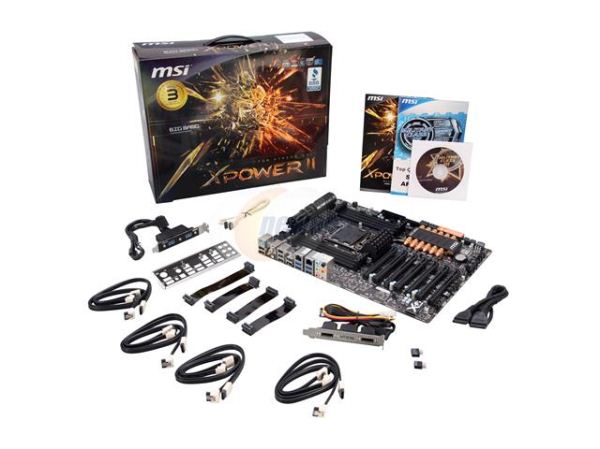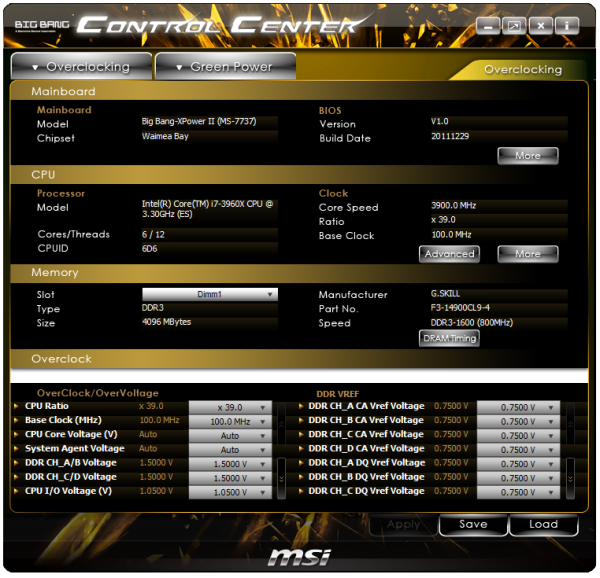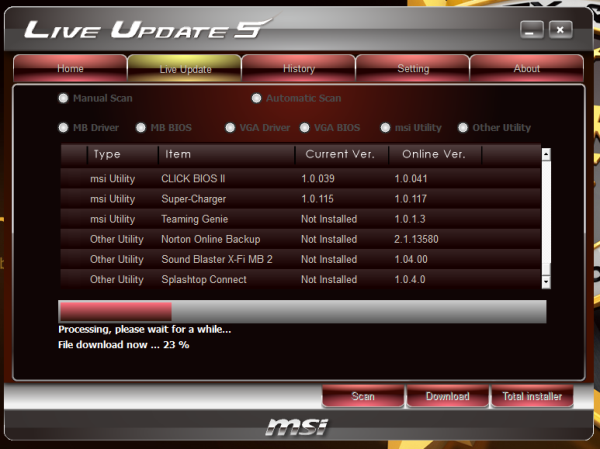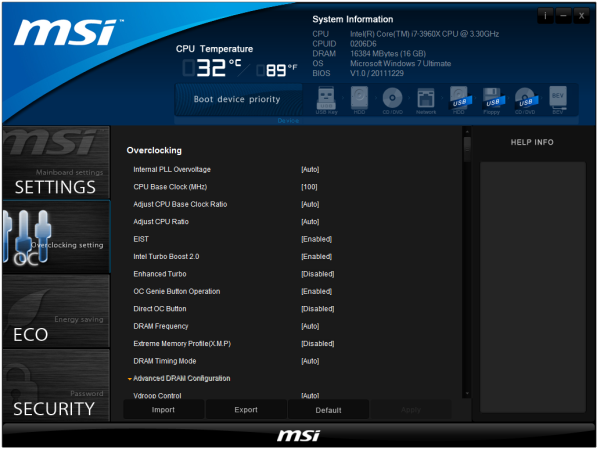MSI Big Bang-XPower II X79 Review – A World of Novelty Heatsinks
by Ian Cutress on February 25, 2012 3:00 PM EST- Posted in
- Motherboards
- MSI
- X79
In The Box
For a product that costs $390, we would hope for a bundle of accessories included in the box. MSI has heeded our call, and I am not disappointed:
Driver CD
User Guide
Software Guide (?)
IO Back Panel
USB 3.0 back panel / front 3.5” panel
Four flexible SLI connectors, various sizes
Front Panel easy connectors
8 SATA cables
eSATA back panel, power connector, and locking eSATA cable
Image courtesy of Newegg
First things first. The eSATA back panel looks like a great bit of kit, so I have to give kudos to MSI on this one. It is a back panel which connects into a 4-pin power and two SATA ports on board. This gives access to 4-pin power and two eSATA ports on the back. MSI has included a durable cable which transforms the 4-pin molex to two SATA power connectors outside the case, to connect to two SATA hard drives. Included is also an eSATA locking SATA cable, making quick work of any eSATA issues you may want at the back of your case.
Also of note is the Software Application manual – having a flip through, it takes you through all the software on the board, including Virtu which is not an X79 feature, which is odd. There are also internal references to iGPU, which may confuse some people. The manual also has not been updated for X79 and Military Class III advertising, as it sports a Military Class II front page. However it does go into more detail than I will below for covering the software on board, so could be worth a flip through if you want to get the most out of your MSI product.
Board Features
| MSI Big Bang-XPower II | |
| Size | ATX |
| CPU Interface | LGA2011 |
| CPU Support | Intel Second Generation Core i7 Sandy Bridge E |
| Chipset | Intel X79 |
| Base Clock Frequency | 100 MHz |
| Core Voltage | Auto, 0.800 V to 1.800 V |
| CPU Clock Multiplier | Auto, 12x to 60x |
| DRAM Voltage | Auto, 1.05 V to 2.445 V |
| DRAM Command Rate | Auto, 1T or 2T |
| Memory Slots |
Eight DDR3 DIMM slots supporting up to 128 GB Up to Quad Channel Support for DDR3, 1066-2400 MHz |
| Expansion Slots |
4 x PCIe Gen 3 x16/x8 3 x PCIe Gen 2 x1 |
| Onboard SATA/RAID |
2 x SATA 6 Gbps, Support for RAID 0, 1, 5, 10 4 x SATA 3 Gbps, Support for RAID 0, 1, 5, 10 4 x SATA 6 Gbps (ASMedia) |
| Onboard |
4 x SATA 3 Gbps (PCH) 6 x SATA 6 Gbps (2 PCH, 4 Controller) 6 x Fan Headers 1 x 6-pin PCIe CFX/SLI Power Connector 2 x USB 2.0 Headers 1 x USB 3.0 Headers Power/Reset Buttons + Debug LED 1 x Clear CMOS jumper 1 x Front Panel Audio 2 x DirectOC Buttons 1 x IEEE 1394 header 1 x OC Genie Button DIP Switches for PCIe Slots |
| Onboard LAN | Dual Intel (82579V and 82574L) |
| Onboard Audio | Realtek ALC898 |
| Power Connectors |
1 x 24-pin ATX connector 2 x 8-pin 12V connector 1 x 6-pin PCIe connector |
| Fan Headers |
1 x CPU Fan Header (4-pin) 5 x SYS Headers (4-pin) |
| IO Panel |
1 x Keyboard/Mouse PS2 Port 1 x Clear CMOS Button 1 x Optical SPDIF Output 1 x Digital SPDIF Output 4 x USB 2.0 6 x USB 3.0 2 x eSATA 3 Gbps 2 x Gigabit Ethernet 1 x IEEE1394/Firewire Audio Outputs |
| BIOS Version | 1.2 |
| Warranty Period | 3 Years |
In terms of features, we are very glad to see two Intel network controllers on board – they fit in nicely with where the board is in terms of price. Having a substantial number of SATA ports helps, although the ASMedia ports are not available for RAID according to the specifications. As I noted before, the audio is not anything special above MSI’s competition, but options like the DirectOC are a bonus for overclockers to have.
Software
MSI’s software for X79 is across a wide range of utilities:
ControlCenter: A series of overclocking options (CPU Ratio, Base Clock, Voltage), green power options, and an option to turn the LEDs on the board off. To enable the features here, the relevant BIOS settings need to be enabled. In terms of changing the CPU ratio on the fly, the user is limited by the max ratio to which the board was booted. Changes here will directly affect BIOS settings as well. To be honest, while it looks nice, it could be laid out a little easier – MSI seem to have created this software on limited horizontal and vertical space, and thus have tried to cram everything in on as few screens as possible. It may be worth separating them across a few more to provide a better user experience.
SuperCharger: One of the USB headers on board has been altered to be able to provide 1.6 A rather than the standard 0.5 A, which allows USB devices to be charged quicker. However, this implementation requires both hardware and software to work in unison, so the MSI software calls the revised power configuration, allowing the user to use the SuperCharger mode when the computer is on or in a shutdown state.
Winki III: Do you ever feel you want to boot into a basic OS with limited functionality very slightly quicker than you can with a typical Windows installation on X79? If you did, then MSI has Winki III – a MSI developed Linux distribution providing update tools, internet browser, instant messaging, Skype, and a photo viewer. This was a feature MSI introduced a few chipsets ago, when taking 30+ seconds to get into the main OS was the norm. Now in the land of X79 and SSDs, it barely seems relevant. However, the option is there if it is needed.
Audio Genie: Provides speaker location settings and THX mode selections.
Video Genie: MSI’s Video Genie software aims to provide automatic color enhancement, saturation enhancement and intelligent gamma correction for static images and video playback.
Teaming Genie: With the use of dual Intel network controllers on the board, they are able to be teamed together to act as one connection with the throughput of both. This is enabled through the Teaming Genie software, which will also support additional suitable network connections as required.
Live Update 5: MSI has handily provided a piece of software to aid in updating the MSI proprietary software – this is Live Update 5. I initially had issues running the version that came with the board; however the website has the latest edition. Through Live Update, the software will detect relevant software and drivers on the board, contact MSI’s servers, and inform you of updates. You then have the option of picking and choosing which ones to download and install. This is all well and good, although there is room for improvement – the system never informed me of the size of the files to be downloaded, or time to completion. So having to wait 30+ minutes for the system to download and update was a bit of a pain.
ClickBIOS II: As motherboard chipsets develop, so do manufacturers' ideas of how to support them. One current trend is to provide OS software which mimics the BIOS so users do not have to deal directly with the BIOS on boot. In MSI’s case, this comes into force through their ClickBIOS software. For all intents and purposes, the software represents a good facsimile of the BIOS itself with very minor changes in layout. The only major difference I have a gripe with is that in these systems the fonts always seem to look out of place. However, a user can interface with the BIOS settings via ClickBIOS with ease.




















45 Comments
View All Comments
Sabresiberian - Sunday, February 26, 2012 - link
Are you kidding me?If you don't want to read a real review, I suggest you stop reading at Anandtech.com. There are plenty of sites that offer popcorn reviews for people like you.
Not everything can be said in a sound bite.
Keep up the good work, Ian!
;)
Iketh - Sunday, February 26, 2012 - link
What are you talking about? You're way off subject.mschira - Saturday, February 25, 2012 - link
So what is the maximum amount of working memory this supports?64 Gb? (8x8) or "only 32 (8x4)
Cheers
M.
earthrace57 - Saturday, February 25, 2012 - link
Most likely 64 GB unless they limited it somehow.I'm pretty sure its just how many GB or ram you can put in 1 stick at the time of making x number of slots...I don't think there really is a limitation.
Someone got 48 GB stable on a X58 motherboard, which is bound to 24 GB supposedly...
Zolcos - Saturday, February 25, 2012 - link
Odd that on such an expensive mobo with dual LAN and both kinds of spdif, they included firewire of all things but left out eSATA from the main cluster? It seems like a 'core' enough feature that it shouldn't require an expansion plate like this one does imo.bigboxes - Saturday, February 25, 2012 - link
This mobo has USB 3.0 so the need for eSATA will be minimal. However, if you still want it they provide a powered dual-eSATA bracket for the back. What more do you want?DanNeely - Sunday, February 26, 2012 - link
In addition because XL-ATX cases have room for 10 expansion slots you could mount the bracket between the main cluster and top GPU; so you it won't cut into your expansion like it would on a standard ATX system.iamkyle - Saturday, February 25, 2012 - link
Surprised the Marvell or Realtek mafia didn't come after MSI. FINALLY a reputable networking solution. Why can't every mainboard manufacturer do this?Iketh - Saturday, February 25, 2012 - link
Asus ROG motherboards have Intel also, along with X-Fi sound. The GENE-Z/GEN3 is only $180. I hope this is selling like hotcakes for them so it sends a message through the industry.Sabresiberian - Sunday, February 26, 2012 - link
The sound solution on Asus' otherwise excellent boards is really not significantly better than what other manufacturers offer without requiring a daughter card to take up the space of another slot.If you want more than what mainboards offer, then a discreet sound solution is still the only way to go. (I might suggest Asus' own products there.)
For my purposes onboard sound is a waste of money in the kind of build I want, I would rather there be no sound components at all built in the MB and the price be a little lower.
;)